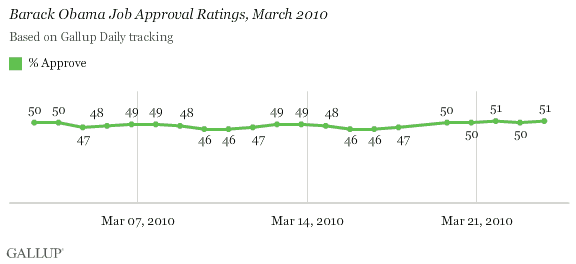PRINCETON, NJ -- President Barack Obama's job approval stands at 51% after the passage of landmark healthcare legislation. That is slightly better than, though not fundamentally changed from, his ratings for most of this month.

These results are based on Gallup Daily tracking from March 22-24, the first measure conducted entirely after the House passed the healthcare reform bill on Sunday night. The passage of the legislation itself met with an initially positive public reaction.
Obama's approval rating has hovered around 50% since November, and was precisely 50% in the last three days of Gallup polling before the vote took place. However, in recent weeks Obama has been consistently below the majority approval level and his ratings were generally the lowest of his presidency. That includes term-low 48% weekly average approval ratings each of the last two weeks, and several 46% ratings in Gallup Daily three-day rolling averages, the most recent coming in March 15-17 polling.
In the latest three-day rolling average, 83% of Democrats, 47% of independents, and 14% of Republicans approve of the job Obama is doing as president. Over the course of the prior week (March 15-21), the president averaged 81% approval among Democrats, 43% from independents, and 13% from Republicans. Thus, it appears all three groups may be marginally more positive about Obama since health reform passed, with a proportionately greater increase among independents.
Bottom Line
The passage of healthcare reform in the House, a major victory for the Obama administration, has not yet had an overwhelmingly positive impact on Obama's approval rating. That may be in part because of the divisiveness over the healthcare reform legislation, which struggled to gain majority public support throughout the process. It appears, though, that the healthcare victory did provide enough momentum to put Obama back above the majority approval level for the time being.
Survey Methods
Results are based on telephone interviews with a random sample of 1,544 national adults, aged 18 and older, conducted March 22-24, 2010. For results based on the total sample of national adults, one can say with 95% confidence that the maximum margin of sampling error is ±4 percentage points.
Interviews are conducted with respondents on land-line telephones and cellular phones.
In addition to sampling error, question wording and practical difficulties in conducting surveys can introduce error or bias into the findings of public opinion polls.
